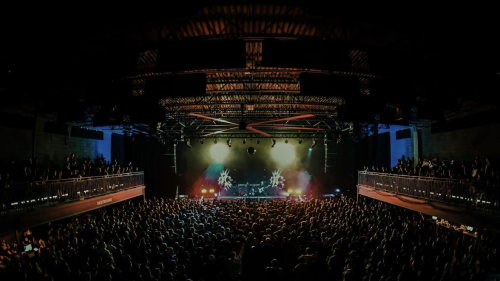Hey guys. Sean here. 👋 Today we’re talking about dirt track racing, something that (if you’re like all my friends and most of my family) you probably haven’t checked off your bucket list.
As a Southerner, I would argue that you absolutely owe it to yourself to experience this part of our culture at least once in your life – because it really is one of the most exciting spectacles you’re likely to see anywhere. Just picture this: dirt flying everywhere, cars on the edge of control, inevitable crashes and close finishes. In a weird way, it’s a relaxing few hours — the noise of the cars, the smell of gasoline mixed with red clay... it’s definitely one of Nooga’s best kept secrets.

The Chattanooga region has four different dirt tracks within driving distance. Each track offers racing events throughout the spring/summer and early fall months.
Dirt Tracks
- Boyd’s Speedway — Ringgold, Georgia
Home to dirt track racing since 1952, Boyd’s is a ⅓ mile banked track just across the state line. You can catch up to six divisions (i.e., different types of cars) racing on Saturday nights during the season. This is the closest track to Chattanooga and one of the best in the South. Click here for the schedule.
- North Georgia Speedway — Chatsworth, Georgia
Another ⅓ mile track, North Georgia Speedway is a lightning fast high-banked oval. A majority of the season’s schedule is slotted for Thursday nights. The track also hosts several regional traveling promotions like the Southern Nationals and sprint car races.
- I-75 Raceway — Sweetwater, Tennessee
Formerly Murphy Speedway, the ⅜ mile semi-banked track offers racing most Saturday nights throughout the spring/summer season. With six divisions racing each night, fans can catch plenty of action with little downtime. A full schedule is here.
- Mountain View Raceway — Spring City, Tennessee
This track sat in disrepair for years and was recently purchased. Renovations are underway and the racing is expected to resume soon. Owners have released a rather dramatic preview video. Needless to say, we’re excited about another area track to attend.
https://www.youtube.com/watch?v=dLHajFWL_qs
History of dirt racing
Dirt track racing is a cultural experience that predates the asphalt-only NASCAR racing style that exploded in the 1970s. During Prohibition, many of the early race car drivers were also moonshine runners, evading the police with expertise + speed and then dominating the dirt tracks on the weekends. In fact, many of the dirt tracks that are still around are located near what is known as The White Lightning corridor, where moonshining running was commonplace back in the day.
But dirt racing isn’t just a Southern activity. It’s easily the most popular form of racing with hundreds of regional dirt tracks throughout the nation. Dirt racing is also popular in Mexico, Australia, Europe and the United Kingdom (where a form called Banger racing encourages crashing).
Locally, tracks feature up to six different divisions on a given night — from the build-it-in-the-garage, front-wheel drive “stinger” and “hornet” cars all the way up to $70,000 + super late model speed machines — with feature races and cash prizes on the line.
For decades, the region’s premier dirt track was the Cleveland Speedway off Exit 20 in Bradley County. In April of 2018, the 60-year-old facility was demolished for development. It had been home to weekly dirt racing since 1954.
The cars
Here is a breakdown of the divisions you might see:
— Street Stocks (i.e., hobby stocks, stingers)
These cars most closely resemble street cars with the exception of a welded roll cage for safety and anything that could break (headlights, glass, etc.) removed.
— Crate Late Model
Late model cars with a standard “crate” engine are designed to level the playing field. In theory, the cars have similar engines so the racing should be closer. Although, some teams have found ways to buck the system.
— Super Late Model
Typically, these are the “main event” cars you’ll see at a local race. And they’re fast + expensive. A new late model race car can set a team back $70,000. The main difference between the Super Late Models and, for example, a Limited Late Model is the engine size.
— Dwarf Legends
These tiny throwbacks are ⅝ scale replicas of 1930s/40s era automobiles. They sometimes have a motorcycle engine and be the most economical way to enter competitive racing.
https://www.youtube.com/watch?v=GWx8QWupu34
The racing format
Most tracks follow a race night schedule that usually looks like this:
Tracks offer at least 4 to 5 divisions on a general racing night. Special events often include a main touring division + 2 or 3 races. There’s plenty of action, in other words.
— Hot Laps
An open practice session for each division. Usually, it’s one or two laps to test the car’s setup and get a feel for the track. The surface can change from night to night depending on moisture and how well the track is tire rubber and dirt are sticking to the track.🏎️
— Qualifying
Some tracks allow the faster divisions — Super Late Models, Crate + Hobby — to qualify individually. Some of those cars — especially if there are more entries than available starting positions — can move onto the main feature (i.e. the big race at the end of the night) while the slower cars have to race their way into the feature through heat races.
— Heat Races
Short races (6-10 laps) that set the starting order for the main event. Drivers can also earn points toward a track championship during the heat races depending on how many passes they make.
— Feature Races
This is what you’ve come for. Depending on the division, these races can be 15 to 50 laps. The winner of the feature is considered the winner of that night’s race in their respective division. They get a fancy trophy and a picture.
https://www.youtube.com/watch?v=ltE1QNvF0rc
Pro-tips: Attending a dirt race
— Expect to pay $15-$20 for a general admission seat. (I always bring my own seat cushion because the metal or wooden grandstands can be hard on the butt. And you’re going to be sitting for a while. )
— Choose your seat wisely: The higher up you sit, the better the view. But some people like to sit closer to the track to feel the power of the cars. You do you. Regardless, you’re going to get some dirt on you and on your skin. So, dress accordingly.
— Bring earplugs. It gets loud. And safety glasses can come in handy if it’s a dry night. Those cars can kick up some dirt.
— Arrive at the track early (6 or 7 p.m) and watch the cars “hot lap” (i.e., practice). Some tracks let you bring in some fast food and a small cooler, but the concession prices are usually inexpensive.
— Talk to the people around you during the quiet times. Some of them have incredible stories and they offer a wealth of knowledge for the novice attendees. Everybody is nice. It’s dirt track racing, after all.
— Watch for the slide. The faster divisions will spend much of the corner sliding sideways because, well, it’s a faster way to get around the track.
— Tempers flare. There is nothing more amusing than a dirt track fight. Adrenaline is high and nobody likes to take home a wrecked race car.
— Having said the above, dirt tracks are family-friendly. Bring the kids. They’ll love it.











